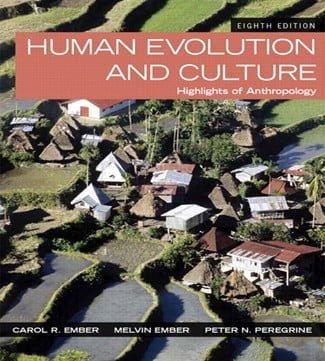This is completed downloadable of Human Evolution and Culture Highlights of Anthropology 8th Edition Ember Ember Peregrine Test Bank

Product Details:
- ISBN-10 : 0205999328
- ISBN-13 : 978-0205999323
- Author:
Human Evolution and Culture presents the highlights of the popular Anthropology, 14th edition by the same author team. This brief introduction presents readers with the four fields of anthropology, helping them to understand humans and all their variety. Students will gain a deeper understanding of 1) anthropology, 2) the biological and cultural evolution of humans, 3) cultural variation, and 4) how anthropology can be applied beyond academia. The new 8th edition includes expanded focus on environmental issues. Additionally, the size of the book (19 chapters) makes it useful for quarter courses, as well as for courses that encourage a lot of supplemental reading.
REVEL from Pearson is an immersive learning experience designed for the way today’s student read, think, and learn. REVEL modernizes familiar and respected course content with dynamic media interactives and assessments, and empowers educators to increase engagement in the course, better connecting with students. The result is increased student engagement and improved learning.
Table of Content:
CHAPTER 3: Genetics and Evolution
Multiple Choice Questions
1. If we think of the history of the universe in terms of 12 months, the history of humanlike primates would have taken up only about __________.
A) 90 minutes
B) 3 hours
C) 10 minutes
D) 1 hour
Question Title: TB_03_01_Introduction_Remember
Answer: A
Learning Objective:
Topic: Introduction
Skill Level: Remember the Facts
Difficulty Level: 1-Easy
2. Modern-looking humans evolved about __________ years ago.
A) 100,000
B) 1,000,000
C) 500,000
D) 10,000
Question Title: TB_03_02_Introduction_Remember
Answer: A
Learning Objective:
Topic: Introduction
Skill Level: Remember the Facts
Difficulty Level: 1-Easy
3. Who classified plants and animals into a systema naturae, which led to the taxonomic system we use today?
A) Carolus Linnaeus
B) Charles Darwin
C) Aristotle
D) Jean-Baptiste Lamarck
Question Title: TB_03_03_The Evolution of Evolution_Remember_3.1
Answer: A
Learning Objective: 3.1 Trace the history of thinking leading to the concept of evolution.
Topic: The Evolution of Evolution
Skill Level: Remember the Facts
Difficulty Level: 2-Moderate
4. Which scientist developed a theory of evolution by way of natural selection at about the same time as Darwin?
A) Alfred Russel Wallace
B) Charles Lyell
C) Thomas Huxley
D) Georges Cuvier
Question Title: TB_03_04_The Evolution of Evolution_Remember_3.1
Answer: A
Learning Objective: 3.1 Trace the history of thinking leading to the concept of evolution.
Topic: The Evolution of Evolution
Skill Level: Remember the Facts
Difficulty Level: 2-Moderate
5. In 1859, Charles Darwin published __________.
A) The Origin of Species by Means of Natural Selection
B) The Descent of Man
C) The Voyage of the Beagle
D) Fauna of the Galapagos Island
Question Title: TB_03_05_The Evolution of Evolution_Remember_3.1
Answer: A
Learning Objective: 3.1 Trace the history of thinking leading to the concept of evolution.
Topic: The Evolution of Evolution
Skill Level: Remember the Facts
Difficulty Level: 2-Moderate
6. The main process that increases the frequency of adaptive traits through time is called __________.
A) natural selection
B) catastrophism
C) uniformitarianism
D) ontogeny
Question Title: TB_03_06_The Principles of Natural Selection_Remember_3.2
Answer: A
Learning Objective: 3.2 Describe the process of natural selection.
Topic: The Principles of Natural Selection
Skill Level: Remember the Facts
Difficulty Level: 1-Easy
7. Gregor Mendel was a pioneer in the field of __________.
A) genetics
B) physics
C) chemistry
D) medicine
Question Title: TB_03_07_The Principles of Natural Selection_Remember_3.2
Answer: A
Learning Objective: 3.2 Describe the process of natural selection.
Topic: The Principles of Natural Selection
Skill Level: Remember the Facts
Difficulty Level: 1-Easy
8. The observable appearance of a pea plant is called its __________.
A) phenotype
B) stereotype
C) prototype
D) genotype
Question Title: TB_03_08_Heredity_Remember_3.3
Answer: A
Learning Objective: 3.3 Specify the principles of genetics.
Topic: Heredity
Skill Level: Remember the Facts
Difficulty Level: 1-Easy
9. Which pair of scientists is famous for discovering the structure of the DNA molecule?
A) Watson and Crick
B) Darwin and Wallace
C) Lyell and Cuvier
D) Malthus and Marx
Question Title: TB_03_09_Heredity_Remember_3.3
Answer: A
Learning Objective: 3.3 Specify the principles of genetics.
Topic: Heredity
Skill Level: Remember the Facts
Difficulty Level: 1-Easy
10. Where does protein synthesis take place?
A) at the ribosome
B) in the nucleus
C) in the mitochondria
D) outside the cell
Question Title: TB_03_10_Heredity_Remember_3.3
Answer: A
Learning Objective: 3.3 Specify the principles of genetics.
Topic: Heredity
Skill Level: Remember the Facts
Difficulty Level: 1-Easy
11. Which base is present in RNA but not in DNA?
A) uracil
B) adenine
C) thymine
D) cytosine
Question Title: TB_03_11_Heredity_Remember_3.3
Answer: A
Learning Objective: 3.3 Specify the principles of genetics.
Topic: Heredity
Skill Level: Remember the Facts
Difficulty Level: 1-Easy
12. __________ is the exchange of sections of chromosomes between one chromosome and another.
A) Crossing-over
B) Speciation
C) Mutation
D) Segregation
Question Title: TB_03_12_Sources of Variability_Remember_3.4
Answer: A
Learning Objective: 3.4 Identify the sources of genetic variability and discuss how each leads to new variations, becomes shuffled through populations, or becomes hybridized.
Topic: Sources of Variability
Skill Level: Remember the Facts
Difficulty Level: 1-Easy
13. Charles Darwin was not the first person to discuss evolutionary processes, but he is famous because he __________.
A) was the first to provide a comprehensive, well-documented explanation of natural selection
B) studied apes extensively and began to draw comparisons with human biology
C) was among the first scientists to explain how traits are passed from one generation to the next
D) was able to see that environment played no role in evolution
Question Title: TB_03_13_The Evolution of Evolution_Understand_3.1
Answer: A
Learning Objective: 3.1 Trace the history of thinking leading to the concept of evolution.
Topic: The Evolution of Evolution
Skill Level: Understand the Concepts
Difficulty Level: 2-Moderate
14. What does Darwinian evolution maintain about the evolutionary relationship between humans and monkeys?
A) Humans and monkeys are descended from a common ancestor that lived long ago.
B) Humans are direct descendents of monkeys.
C) Humans and monkeys are only related to the extent that they are both mammals.
D) Humans and monkeys are not biologically related at all.
Question Title: TB_03_14_The Evolution of Evolution_Understand_3.1
Answer: A
Learning Objective: 3.1 Trace the history of thinking leading to the concept of evolution.
Topic: The Evolution of Evolution
Skill Level: Understand the Concepts
Difficulty Level: 3-Difficult
15. What happens to a species when environments change?
A) Different traits will become adaptive.
B) They will all go extinct and be replaced by new species.
C) They will grow bigger in response to the environmental change.
D) There is no change in a species’ evolution.
Question Title: TB_03_15_The Principles of Natural Selection_Understand_3.2
Answer: A
Learning Objective: 3.2 Describe the process of natural selection.
Topic: The Principles of Natural Selection
Skill Level: Understand the Concepts
Difficulty Level: 3-Difficult
16. Natural selection cannot account for the variation in frequency of __________ traits.
A) neutral
B) adaptive
C) maladaptive
D) unusual
Question Title: TB_03_16_The Principles of Natural Selection_Understand_3.2
Answer: A
Learning Objective: 3.2 Describe the process of natural selection.
Topic: The Principles of Natural Selection
Skill Level: Understand the Concepts
Difficulty Level: 2-Moderate
17. What is a dominant trait?
A) one which is always expressed in the presence of another variant
B) one which is repressed by the presence of another variant
C) a trait that is most common in a population
D) a trait that is less common in a population
Question Title: TB_03_17_Heredity_Understand_3.3
Answer: A
Learning Objective: 3.3 Specify the principles of genetics.
Topic: Heredity
Skill Level: Understand the Concepts
Difficulty Level: 2-Moderate
18. Mendel’s units of heredity were what we now call __________.
A) genes
B) chromosomes
C) DNA
D) gametes
Question Title: TB_03_18_Heredity_Understand_3.3
Answer: A
Learning Objective: 3.3 Specify the principles of genetics.
Topic: Heredity
Skill Level: Understand the Concepts
Difficulty Level: 1-Easy
19. If two alleles for a trait are the same, the organism is __________ for the trait.
A) homozygous
B) heterozygous
C) monozygous
D) bizygous
Question Title: TB_03_19_Heredity_Understand_3.3
Answer: A
Learning Objective: 3.3 Specify the principles of genetics.
Topic: Heredity
Skill Level: Understand the Concepts
Difficulty Level: 2-Moderate
20. Which of these statements is true regarding human chromosomes?
A) Egg and sperm cells have 23 chromosomes, while all other body cells contain 46.
B) All body cells divide through a process called meiosis.
C) Chromosomes divide only once in a person’s lifetime.
D) Children receive all of their chromosomes from either their mother or their father.
Question Title: TB_03_20_Heredity_Understand_3.3
Answer: A
Learning Objective: 3.3 Specify the principles of genetics.
Topic: Heredity
Skill Level: Understand the Concepts
Difficulty Level: 3-Difficult
21. What does messenger RNA do?
A) It copies the information on DNA for use in protein synthesis.
B) It tells the cell when it is time to divide.
C) It stays inside the nucleus to direct DNA replication.
D) It determines which genes will be expressed in the DNA.
Question Title: TB_03_21_Heredity_Understand_3.3
Answer: A
Learning Objective: 3.3 Specify the principles of genetics.
Topic: Heredity
People Also Search:
human evolution and culture highlights of anthropology 8th
human evolution and culture highlights of anthropology 8th download scribd
human evolution and culture highlights of anthropology 8th test bank download pdf





